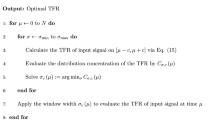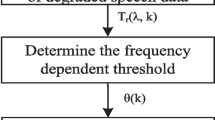Abstract
The least mean p-power (LMP) is one of the most popular adaptive filtering algorithms. With a proper p value, the LMP can outperform the traditional least mean square \((p=2)\), especially under the impulsive noise environments. In sparse channel estimation, the unknown channel may have a sparse impulsive (or frequency) response. In this paper, our goal is to develop new LMP algorithms that can adapt to the underlying sparsity and achieve better performance in impulsive noise environments. Particularly, the correntropy induced metric (CIM) as an excellent approximator of the \(l_0\)-norm can be used as a sparsity penalty term. The proposed sparsity-aware LMP algorithms include the \(l_1\)-norm, reweighted \(l_1\)-norm and CIM penalized LMP algorithms, which are denoted as ZALMP, RZALMP and CIMLMP respectively. The mean and mean square convergence of these algorithms are analysed. Simulation results show that the proposed new algorithms perform well in sparse channel estimation under impulsive noise environments. In particular, the CIMLMP with suitable kernel width will outperform other algorithms significantly due to the superiority of the CIM approximator for the \(l_0\)-norm.




Similar content being viewed by others
References
Rontogiannis, A.A., Berberidis, K.: Efficient decision feedback equalization for sparse wireless channels. IEEE Trans. Wirel. Commun. 2(3), 570–581 (2003)
Singer, A.C., Nelson, J.K., Kozat, S.S.: Signal processing for underwater acoustic communications. IEEE Commun. Mag. 47(1), 90–96 (2009)
Cotter, S., Rao, B.: Sparse channel estimation via matching pursuit with application to equalization. IEEE Trans. Commun. 50(3), 374–378 (2002)
Yousef, N.R., Sayed, A.H., Khajehnouri, N.: Detection of fading overlapping multipath components. Signal Process. 86(9), 2407–2425 (2006)
Duttweiler, D.L.: Proportionate normalized least-mean-squares adaptation in echo cancellers. IEEE Trans. Speech Audio Process. 8(5), 508–518 (2000)
Arenas-García, J., Figueiras-Vidal, A.R.: Adaptive combination of proportionate filters for sparse echo cancellation. IEEE Trans. Audio Speech Lang. Process. 17(6), 1087–1098 (2009)
Chen, Y., Gu, Y., Hero, A.O.: Sparse LMS for system identification. In: IEEE International Conference on Acoustics, Speech and Signal Processing (ICASSP), pp. 3125–3128 (2009)
Babadi, B., Kalouptsidis, N., Tarokh, V.: SPARLS: The sparse RLS algorithm. IEEE Trans. Signal Process. 58(8), 4013–4025 (2010)
Su, G., Jin, J., Gu, Y., et al.: Performance analysis of norm constraint least mean square algorithm. IEEE Trans. Signal Process. 60(5), 2223–2235 (2012)
Gui, G., Mehbodniya, A., Adachi, F.: Least mean square/fourth algorithm for adaptive sparse channel estimation. In: 2013 IEEE 24th International Symposium on Personal Indoor and Mobile Radio Communications (PIMRC), pp. 296–300 (2013)
Jahromi, M.S., Salman, M.S., Hocanin, A.: Convergence analysis of the zero-attracting variable step-size LMS algorithm for sparse system identification. Signal Image Video Process. (2014). doi:10.1007/s11760-013-0580-9
Aliyu, M.L., Alkassim, M.A., Salman, M.S.: A p-norm variable step-size LMS algorithm for sparse system identification. Signal Image Video Process. (2013). doi:10.1007/s11760-013-0610-7
Brockett, P.L., Hinich, M., Wilson, G.R.: Nonlinear and non-Gaussian ocean noise. J. Acoust. Soc. Am. 82(4), 1386–1394 (1987)
Weng, B., Barner, K.E.: Nonlinear system identification in impulsive environments. IEEE Trans. Signal Process. 53(7), 2588–2594 (2005)
Sayin, M.O., Vanli, N.D., Kozat, S.S.: A novel family of adaptive filtering algorithms based on the logarithmic cost. IEEE Trans. Signal Process. 62(17), 4411–4424 (2014)
Gunay, O., Toreyin, B.U., Kose, K., Cetin, A.E.: Entropy-functional-based online adaptive decision fusion framework with application to wildfire detection in video. IEEE Trans. Image Process. 21(5), 2853–2865 (2012)
Pelekanakis, K., Chitre, M.: Adaptive sparse channel estimation under symmetric alpha-stable noise. IEEE Trans. Wirel. Commun. 13(6), 3183–3195 (2014)
Liu, W., Puskarel, P.P., Principe, J.C.: Correntropy: properties and applications in non-Gaussian signal processing. IEEE Trans. Signal Process. 55(11), 5286–5298 (2007)
Seth, S., Príncipe, J.C.C.: Compressed signal reconstruction using the correntropy induced metric. In: IEEE International Conference on Acoustics, Speech and Signal Processing (ICASSP), pp. 3845–3848 (2008)
Pei, S.C., Tseng, C.C.: Least mean p-power error criterion for adaptive FIR filter. IEEE J. Sel. Areas Commun. 12(9), 1540–1547 (1994)
Arikan, O., Enis Cetin, A., Erzin, E.: Adaptive filtering for non-Gaussian stable processes. IEEE Signal Process. Lett. 1(11), 163–165 (1994)
Arikan, O., Belge, M., Cetin, A.E., et al.: Adaptive filtering approaches for non-Gaussian stable processes. In: 1995 International Conference on Acoustics, Speech, and Signal Processing (ICASSP-95), pp. 1400–1403 (1995)
Aydin, G., Arikan, O., Cetin, A.E.: Robust adaptive filtering algorithms for \(\alpha \)-stable random processes. IEEE Trans. Circuits Syst. II: Analog Digit. Signal Process. 46(2), 198–202 (1999)
Chen, B., Príncipe, J.C.: Maximum correntropy estimation is a smoothed MAP estimation. IEEE Signal Process. Lett. 19(8), 491–494 (2012)
Shi, K., Shi, P.: Convergence analysis of sparse LMS algorithms with \(l_1\)-norm penalty based on white input signal. Signal Process. 90(12), 3289–3293 (2010)
Taheri, O., Vorobyov, S.A.: Reweighted \(l_1\)-norm penalized LMS for sparse channel estimation and its analysis. Signal Process. 104, 70–79 (2014)
Shao, M., Nikias, C.L.: Signal processing with fractional lower order moments: stable processes and their applications. Proc. IEEE 81(7), 986–1010 (1993)
Acknowledgments
This work was supported by 973 Program (2015CB351703), National Natural Science Foundation of China (61371807, 61372152), and Key Project of major national science and technology on new generation of broadband wireless mobile communication network (2012ZX03001023-003, 2012ZX03001008-003, 2013ZX03002010-003).
Author information
Authors and Affiliations
Corresponding author
Rights and permissions
About this article
Cite this article
Ma, W., Chen, B., Qu, H. et al. Sparse least mean p-power algorithms for channel estimation in the presence of impulsive noise. SIViP 10, 503–510 (2016). https://doi.org/10.1007/s11760-015-0757-5
Received:
Revised:
Accepted:
Published:
Issue Date:
DOI: https://doi.org/10.1007/s11760-015-0757-5




